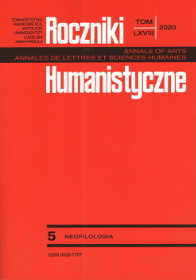Gendering the Holocaust: Robert McLiam Wilson’s Manfred’s Pain and Marek Soból’s Mojry
Abstract
This article analyses two Holocaust novels, Manfred’s Pain (1992) by the Northern Irish novelist Robert McLiam Wilson and Mojry (2005) by the Polish writer Marek Soból, as texts which foreground the female body, female sensibility and the female version of (his)story. Both novels link this theme to sexual violence and emphasise the specificity of the female experience of the Holocaust. This article argues that the gendering of the Holocaust and the focus on its female side constitutes a fundamental difference setting the two novels apart from other, chiefly ‘male’, Holocaust novels, both by Polish authors and by Wilson. The male experience, usually naturalised as the universal human one, is dislocated in these two novels to also include the female perspective. In the case of Manfred’s Pain, this dislocation operates by a change of proportions: although the novel has a male protagonist and narrator, with the female figure seemingly occupying the background, the latter gradually emerges as an equally important protagonist and the female experience becomes as central as the male one. In Soból’s novel, the roles are already reversed: it is the women who come to the fore both as protagonists and narrators, and the text presents both their experience and their points of view, with the male characters reduced to the status of witnesses. Focusing on the fate of women, the novels ‘gender’ the seemingly universal experience of the Holocaust, and draw attention to its gender specificity.
References
Benigni, Roberto, dir. Life Is Beautiful. Perf. Roberto Benigni and Nicoletta Braschi. Melampo Cinematographica, 1997.
Ejchenbaum, B[oris] M[ikhajlovich]. “Iluzja narracji mówionej.” Rosyjska szkoła stylistyki, edited by Maria Renata Mayenowa and Zygmunt Saloni, Państwowy Instytut Wydawniczy, 1970: 487-488.
Ejchenbaum, B[oris] M[ikhajlovich]. “Jak jest zrobiony Płaszcz Gogola.” Rosyjska szkoła stylistyki, edited by Maria Renata Mayenowa and Zygmunt Saloni, Państwowy Instytut Wydawniczy, 1970: 489-490.
Fanon, Frantz. Wyklęty lud ziemi. Translated by Hanna Tygielska, Państwowy Instytut Wydawniczy, 1985.
Jacobson, Howard. J. Jonathan Cape, 2014.
Kędra-Kardela, Anna. “The Theme of Trauma in Elizabeth Bowen’s War Stories.” Margins and Centres Reconsidered, edited by Barbara Klonowska and Zofia Kolbuszewska, Towarzystwo Naukowe KUL, 2008, pp. 49-56.
Magennis, Caroline. Sons of Ulster. Masculinity in the Contemporary Northern Irish Novel. Peter Lang, 2011.
Onega, Susana, and Jean-Michel Ganteau. “Traumatic Realism and Romance in Contemporary British Narrative.” Trauma and Romance in Contemporary British Literature, edited by Jean-Michel Ganteau and Susana Onega, Routledge, 2013, pp. 1-13.
Ostachowicz, Igor. Noc żywych Żydów. Wydawnictwo W. A. B., 2012.
Paziński, Piotr. Pensjonat. Wydawnictwo Nisza, 2009.
Soból, Marek. Mojry. Wydawnictwo W. A. B., 2005.
Szewc, Piotr. Zagłada. Wydawnictwo Literackie, 1987
Thomas, D.M. The White Hotel. Penguin, 1981.
Wilson, Robert McLiam. Manfred’s Pain. Picador, 1992.
Copyright (c) 2020 Roczniki Humanistyczne

This work is licensed under a Creative Commons Attribution-NonCommercial-NoDerivatives 4.0 International License.





